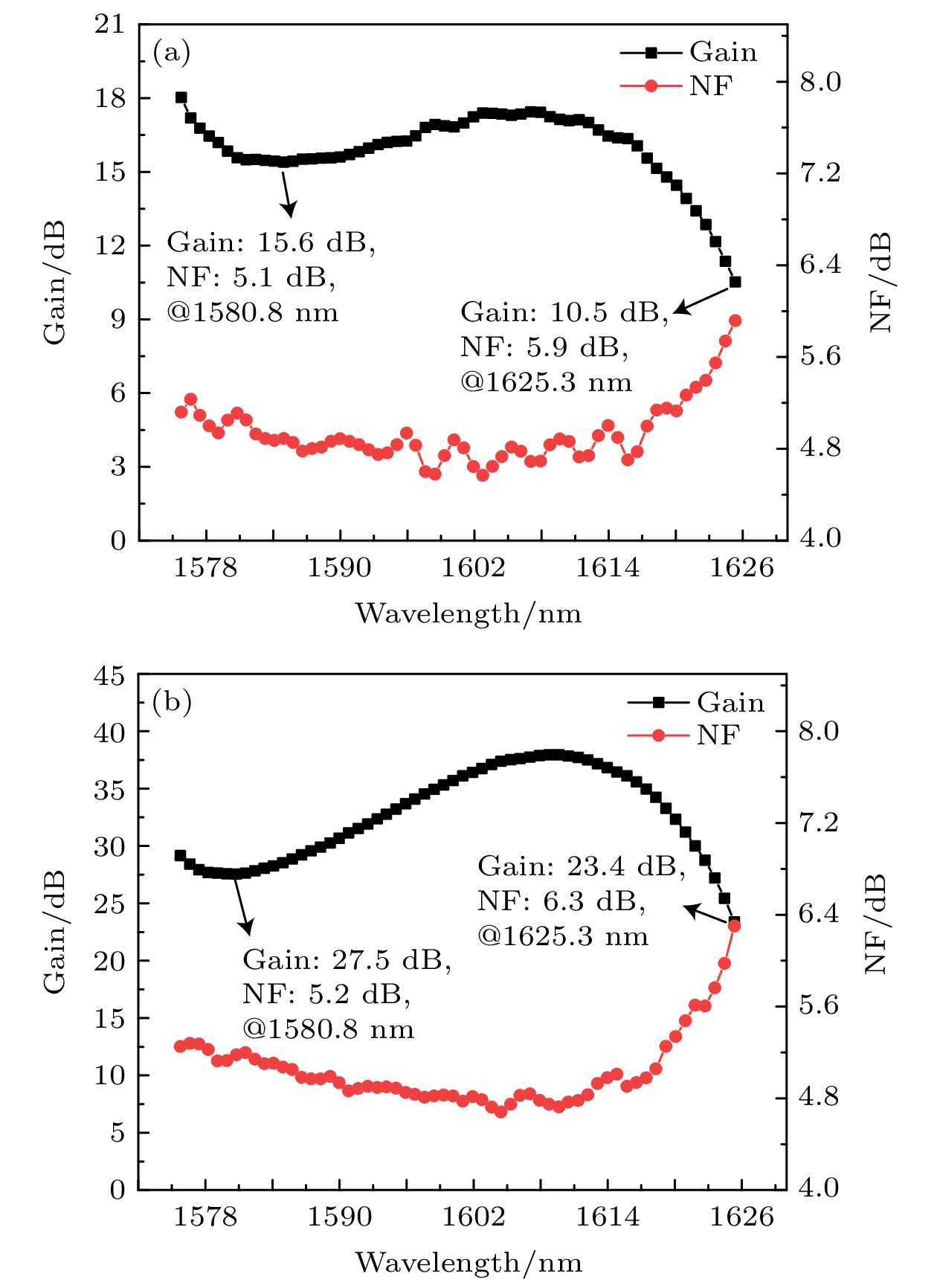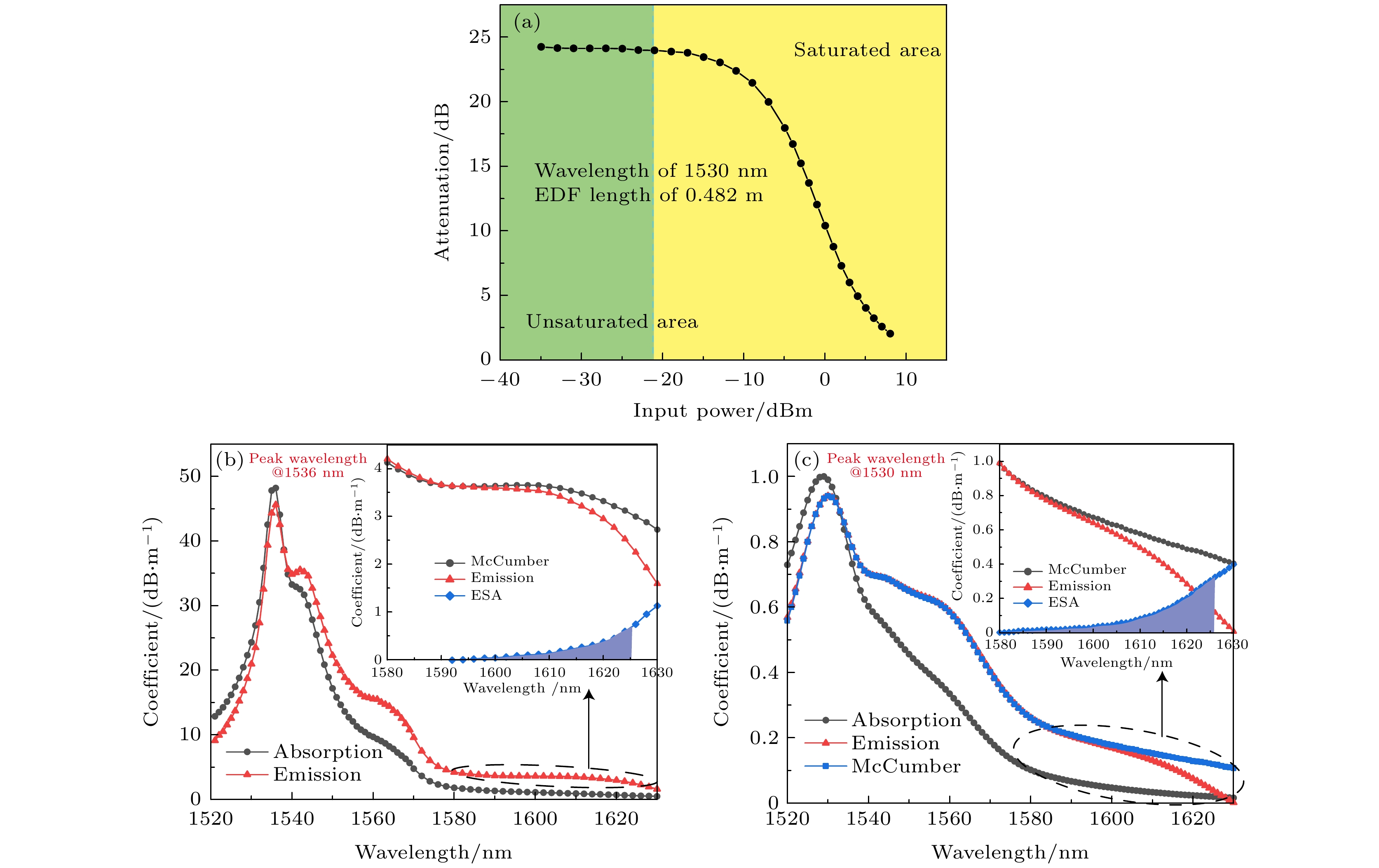-
掺铒光纤放大器的增益带宽是限制光纤通信系统传输容量提升的重要因素. 受铒离子激发态吸收所限, 常规L波段掺铒光纤难以实现更长波段的带宽扩展. 本文基于改进的化学气相沉积工艺成功制备了P/Al共掺石英基L波段扩展掺铒光纤, 研究了共掺离子对于铒离子4I13/2能级到4I9/2能级激发态吸收的影响. 通过分别搭建单级前向泵浦和多级的放大结构, 测试了其宽带放大性能. 基于前向980 nm泵浦的单级结构, 当输入信号功率为–9 dBm, 泵浦功率为530 mW时, 该光纤在1625.3 nm处增益达10.5 dB, 最大噪声指数为5.9 dB. 多级放大结构下, 该光纤在1625.3 nm处增益可达23.4 dB. 实验结果表明P/Al共掺石英基掺铒光纤可以有效抑制铒离子的激发态吸收, 为进一步扩展L波段增益带宽提供了强有力的可行方案.
-
关键词:
- 光纤通信 /
- L波段扩展掺铒光纤放大器 /
- 掺铒光纤 /
- 激发态吸收
With the continuous development of mobile internet, cloud computing, Internet of things, and 5G, the annual growth rate of the existing communication transmission capacity is far from meeting the growing demand. The gain bandwidth of L-band erbium-doped fiber amplification (EDFA) has become the main factor for limiting the bandwidth extension. Owing to its negative effect on the gain and noise figure after 1580 nm, the excited state absorption (ESA) is regarded as a key factor that directly limits the L-band expansion of EDFA. If the ESA coefficient has the same value as the stimulated emission coefficient, the net gain coefficient becomes zero. At the same time, signal amplification cannot be obtained no matter how the pump power and fiber length are adjusted. Improvements from the perspective of erbium-doped fibers, such as changing the host glass and doping components, are extremely beneficial to L-band extension based on simple amplifier configurations. In the present study, an erbium-doped fiber extended to the L-band is fabricated by the modified chemical vapor deposition technology. The saturation curve of the fiber is measured, and then the rate of clustering is obtained. In addition, the absorption coefficient and emission coefficient of the fiber are tested by the truncation method, then the effect of ESA is studied. We demonstrate that modulating the ratio of P to Al in the fiber core has a significant inhibitory effect on the ESA of Er3+. To better characterize the amplification performance of the fiber, a single-stage and a multi-stage amplifier system are built respectively. At an input signal injection with a power value of –9 dBm, the fiber exhibits a gain of 10.5 dB with a maximum noise figure of 5.9 dB at 1625.3 nm, based on a single-stage amplifier system under a 980 nm forward-pumping excitation. It indicates that the amplification performance of the fiber in the long-wavelength has improved, which is consistent with the conclusion of the suppression effect on the ESA. By optimizing the fiber length for the first, second and third stage to 19 m, 26 m and 10 m, respectively, a gain of 23.4 dB is obtained at the longest wavelength. The maximum noise figure is 6.3 dB, and the saturation output power is 24.8 dBm. In the meantime, the pump conversion efficiency arrives at 13%. This is the first report on the L-band extended silicate-based erbium-doped fiber that can achieve long-wavelength gain extension to 1625.3 nm.-
Keywords:
- optics fiber communications /
- extended L-band erbium-doped fiber amplification /
- erbium-doped fiber /
- excited state absorption
[1] Peter J W, David T N, Andrew R C 2018 Optics Express 26 18
 Google Scholar
Google Scholar
[2] 余少华, 何炜 2020 中国科学: 信息科学 50 9
Yu S H, He W 2020 Science in China (Information Sciences) 50 9
[3] 阮江冉, 裴丽, 郑晶晶, 王建帅, 徐文轩, 李晶, 宁提纲 2022 光学学报 42 8
 Google Scholar
Google Scholar
Ruan J R, Pei L, Zheng J J, Wang J S, Xu W X, Li J, Ning T G 2022 Acta Opti. Sin. 42 8
 Google Scholar
Google Scholar
[4] Lei C M, Feng H L, Wang L X, Messaddeq Y, Larochelle S 2020 Optical Fiber Communication Conference & Exhibit California, United States, March 8–12, 2020 pW1C.2
[5] Durak F E, Altuncu A 2017 Optics Commun. 386 31
 Google Scholar
Google Scholar
[6] Masuda H, Miyamoto Y 2008 Electr. Lett. 44 1082
 Google Scholar
Google Scholar
[7] Fujiwara M, Koma R, Suzuki K I, Otaka A 2016 J. Lightwave Technol. 34 8
 Google Scholar
Google Scholar
[8] Amin M Z, Qureshi K K, Hossain M M 2019 Chin. Optics Lett. 17 1
 Google Scholar
Google Scholar
[9] Mori A, Ohishi Y, Yamada M, Ono H, Sudo S 2002 European Conference on Optical Communications Edinburgh, United Kingdom, September 22–25, 1997 p135
[10] Ellison A J G, Goforth D E, Samson B N, Minelly J D, Trentelman J P, McEnroe D L 2001 Optical Fiber Communication Conference & Exhibit California, United States, March 17, 2001 pTuA2
[11] Mori A, Sakamoto T, Kobayashi K, Shikamo K, Oikawa K, Hoshino K, Kanamori T, Ohishi Y, Shizumu M 2002 J. Lightwave Technol. 20 5
 Google Scholar
Google Scholar
[12] Yamashita T, Yoshida M, Tanaka H 2002 Optical Fiber Communication Conference & Exhibit California, United States, March 17, 2002 pThJ1
[13] Guan B O, Tam H Y, Liu S Y, Wai P K A, Sugimoto N 2003 IEEE Photonics Technol. Lett. 15 11
 Google Scholar
Google Scholar
[14] Li Q, Fortusini D, Benjamin S D, Qi G, Kelkar P V, da Silva V L 2002 Optical Fiber Communication Conference & Exhibit California, United States, March 17, 2002 pThJ4
[15] Fu Y J, Zheng K, Jian W, Jian S S 2005 Chin. Opt. Lett. 3 4
[16] Paul M C, Harun S W, Huri N A D, Hamzah A, Das S, Pal M, Bhzdra S K, Ahmad H, Yoo S, Kalita M P, Boyland A J, Sahu J K 2010 J. Lightwave Technol. 28 20
 Google Scholar
Google Scholar
[17] Lou Y, Chen Y, Gu Z M, Qiu Q, He L, Xing Y B, Peng J G, Li H Q, Chu Y B, Dai N L, Li J Y 2021 J. Lightwave Technol. 39 18
 Google Scholar
Google Scholar
[18] Chen Y, Lou Y, Gu Z M, Qiu Q, He L, Li W Z, Yin X K, Zhao X Y, Liu S K, Peng J G, Li H Q, Xing Y B, Chu Y B, Dai N L, Li J Y 2021 Optics Express. 46 23
 Google Scholar
Google Scholar
[19] McCumber D E 1964 Phys. Rev. 136 4A
 Google Scholar
Google Scholar
[20] Brow R K 2000 J. Non-Crystalline Solids 263 1
 Google Scholar
Google Scholar
-
图 5 掺铒光纤参数对比结果 (a) 光纤饱和曲线; (b) 本文光纤吸收系数、发射系数和ESA系数谱; (c) 常规L波段掺铒光纤吸收系数、发射系数和ESA系数谱
Fig. 5. Comparison of erbium-doped fiber basic parameters: (a) Saturation curve of fiber; (b) optical fiber absorption coefficient, emission coefficient and ESA coefficient spectrum in this paper; (c) spectrum of absorption coefficient, emission coefficient and ESA coefficient of conventional L-band erbium-doped fiber.
表 1 国内外L波段扩展EDFA研究进展
Table 1. Research progress of L-band extended EDFA.
年份 机构 基质材料 掺杂离子 扩展波长/nm 文献 1997 NTT (Japan) fluoride Er 1620.0 [9] 2001 Corning (USA) antimony silicate Er 1620.0 [10] 2002 NTT (Japan) tellurite Er 1610.0 [11] 2002 KDDI (Japan) silicate Er/P/Al 1616.1 [12] 2003 PolyU (China HK) bismuthate Er/La 1620.0 [13] 2002 Corning (USA) silicate Er/Al 1620.0 [14] 2005 BJTU (China) silicate Er/Al/Mg 1610.0 [15] 2008 NTT (Japan) silicate Er/P 1619.6 [6] 2010 Central Glass and Ceramic Research Institute (India) silicate Er/Al/Zr/Y 1605.0 [16] 2021 HUST (China) silicate Er/Ce 1623.0 [17] 2021 HUST (China) silicate Er/Yb/P 1623.0 [18] 2022 HUST (China) silicate Er/P/Al 1625.3 This work 表 2 光纤基本参数
Table 2. Basic characteristics of fiber.
数值
孔径吸收系数
@980 nm dB/m吸收系数
@1536 nm dB/m发射系数
@1536 nm dB/m背景损耗
@1200 nm dB/m团簇率/% 0.19 10.57 48.20 45.60 18.00 2.42 -
[1] Peter J W, David T N, Andrew R C 2018 Optics Express 26 18
 Google Scholar
Google Scholar
[2] 余少华, 何炜 2020 中国科学: 信息科学 50 9
Yu S H, He W 2020 Science in China (Information Sciences) 50 9
[3] 阮江冉, 裴丽, 郑晶晶, 王建帅, 徐文轩, 李晶, 宁提纲 2022 光学学报 42 8
 Google Scholar
Google Scholar
Ruan J R, Pei L, Zheng J J, Wang J S, Xu W X, Li J, Ning T G 2022 Acta Opti. Sin. 42 8
 Google Scholar
Google Scholar
[4] Lei C M, Feng H L, Wang L X, Messaddeq Y, Larochelle S 2020 Optical Fiber Communication Conference & Exhibit California, United States, March 8–12, 2020 pW1C.2
[5] Durak F E, Altuncu A 2017 Optics Commun. 386 31
 Google Scholar
Google Scholar
[6] Masuda H, Miyamoto Y 2008 Electr. Lett. 44 1082
 Google Scholar
Google Scholar
[7] Fujiwara M, Koma R, Suzuki K I, Otaka A 2016 J. Lightwave Technol. 34 8
 Google Scholar
Google Scholar
[8] Amin M Z, Qureshi K K, Hossain M M 2019 Chin. Optics Lett. 17 1
 Google Scholar
Google Scholar
[9] Mori A, Ohishi Y, Yamada M, Ono H, Sudo S 2002 European Conference on Optical Communications Edinburgh, United Kingdom, September 22–25, 1997 p135
[10] Ellison A J G, Goforth D E, Samson B N, Minelly J D, Trentelman J P, McEnroe D L 2001 Optical Fiber Communication Conference & Exhibit California, United States, March 17, 2001 pTuA2
[11] Mori A, Sakamoto T, Kobayashi K, Shikamo K, Oikawa K, Hoshino K, Kanamori T, Ohishi Y, Shizumu M 2002 J. Lightwave Technol. 20 5
 Google Scholar
Google Scholar
[12] Yamashita T, Yoshida M, Tanaka H 2002 Optical Fiber Communication Conference & Exhibit California, United States, March 17, 2002 pThJ1
[13] Guan B O, Tam H Y, Liu S Y, Wai P K A, Sugimoto N 2003 IEEE Photonics Technol. Lett. 15 11
 Google Scholar
Google Scholar
[14] Li Q, Fortusini D, Benjamin S D, Qi G, Kelkar P V, da Silva V L 2002 Optical Fiber Communication Conference & Exhibit California, United States, March 17, 2002 pThJ4
[15] Fu Y J, Zheng K, Jian W, Jian S S 2005 Chin. Opt. Lett. 3 4
[16] Paul M C, Harun S W, Huri N A D, Hamzah A, Das S, Pal M, Bhzdra S K, Ahmad H, Yoo S, Kalita M P, Boyland A J, Sahu J K 2010 J. Lightwave Technol. 28 20
 Google Scholar
Google Scholar
[17] Lou Y, Chen Y, Gu Z M, Qiu Q, He L, Xing Y B, Peng J G, Li H Q, Chu Y B, Dai N L, Li J Y 2021 J. Lightwave Technol. 39 18
 Google Scholar
Google Scholar
[18] Chen Y, Lou Y, Gu Z M, Qiu Q, He L, Li W Z, Yin X K, Zhao X Y, Liu S K, Peng J G, Li H Q, Xing Y B, Chu Y B, Dai N L, Li J Y 2021 Optics Express. 46 23
 Google Scholar
Google Scholar
[19] McCumber D E 1964 Phys. Rev. 136 4A
 Google Scholar
Google Scholar
[20] Brow R K 2000 J. Non-Crystalline Solids 263 1
 Google Scholar
Google Scholar
计量
- 文章访问数: 11466
- PDF下载量: 268
- 被引次数: 0














 下载:
下载:




